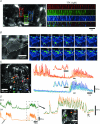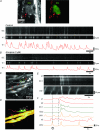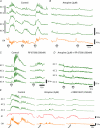Ca2+ imaging of activity in ICC-MY during local mucosal reflexes and the colonic migrating motor complex in the murine large intestine
- PMID: 20876203
- PMCID: PMC3008851
- DOI: 10.1113/jphysiol.2010.196824
Ca2+ imaging of activity in ICC-MY during local mucosal reflexes and the colonic migrating motor complex in the murine large intestine
Abstract
Colonic migrating motor complexes (CMMCs) are neurally mediated, cyclical contractile and electrical events, which typically propagate along the colon every 2-3 min in the mouse. We examined the interactions between myenteric neurons, interstitial cells of Cajal in the myenteric region (ICC-MY) and smooth muscle cells during CMMCs using Ca(2+) imaging. CMMCs occurred spontaneously or were evoked by stimulating the mucosa locally, or by brushing it at either end of the colon. Between CMMCs, most ICC-MY were often quiescent; their lack of activity was correlated with ongoing Ca(2+) transients in varicosities on the axons of presumably inhibitory motor neurons that were on or surrounded ICC-MY. Ca(2+) transients in other varicosities initiated intracellular Ca(2+) waves in adjacent ICC-MY, which were blocked by atropine, suggesting they were on the axons of excitatory motor neurons. Following TTX (1 μM), or blockade of inhibitory neurotransmission with N(ω)-nitro-L-arginine (L-NA, a NO synthesis inhibitor, 10 μM) and MRS 2500 (a P2Y(1) antagonist, 1 μM), ongoing spark/puff like activity and rhythmic intracellular Ca(2+) waves (38.1 ± 2.9 cycles min(-1)) were observed, yet this activity was uncoupled, even between ICC-MY in close apposition. During spontaneous or evoked CMMCs there was an increase in the frequency (62.9 ± 1.4 cycles min(-1)) and amplitude of Ca(2+) transients in ICC-MY and muscle, which often had synchronized activity. At the same time, activity in varicosites along excitatory and inhibitory motor nerve fibres increased and decreased respectively, leading to an overall excitation of ICC-MY. Atropine (1 μM) reduced the evoked responses in ICC-MY, and subsequent addition of an NK1 antagonist (RP 67580, 500 nM) completely blocked the responses to stimulation, as did applying these drugs in reverse order. An NKII antagonist (MEN 10,376, 500 nM) had no effect on the evoked responses in ICC-MY. Following TTX application, carbachol (1 μM), substance P (1 μM) and an NKI agonist (GR73632, 100 nM) produced the fast oscillations superimposed on a slow increase in Ca(2+) in ICC-MY, whereas SNP (an NO donor, 10 μM) abolished all activity in ICC-MY. In conclusion, ICC-MY, which are under tonic inhibition, are pacemakers whose activity can be synchronized by excitatory nerves to couple the longitudinal and circular muscles during the CMMC. ICC-MY receive excitatory input from motor neurons that release acetylcholine and tachykinins acting on muscarinic and NK1 receptors, respectively.
Figures











Similar articles
-
Calcium activity in different classes of myenteric neurons underlying the migrating motor complex in the murine colon.J Physiol. 2010 Feb 1;588(Pt 3):399-421. doi: 10.1113/jphysiol.2009.181172. Epub 2009 Nov 30. J Physiol. 2010. PMID: 19948652 Free PMC article.
-
Activity in varicosities within the myenteric plexus between and during the colonic migrating motor complex in the isolated murine large intestine.Neurogastroenterol Motil. 2012 Apr;24(4):e185-201. doi: 10.1111/j.1365-2982.2012.01892.x. Epub 2012 Feb 14. Neurogastroenterol Motil. 2012. PMID: 22332643 Free PMC article.
-
The mechanisms underlying the generation of the colonic migrating motor complex in both wild-type and nNOS knockout mice.Am J Physiol Gastrointest Liver Physiol. 2010 Feb;298(2):G222-32. doi: 10.1152/ajpgi.00399.2009. Epub 2009 Dec 3. Am J Physiol Gastrointest Liver Physiol. 2010. PMID: 19959818 Free PMC article.
-
A model of the enteric neural circuitry underlying the generation of rhythmic motor patterns in the colon: the role of serotonin.Am J Physiol Gastrointest Liver Physiol. 2017 Jan 1;312(1):G1-G14. doi: 10.1152/ajpgi.00337.2016. Epub 2016 Oct 27. Am J Physiol Gastrointest Liver Physiol. 2017. PMID: 27789457 Free PMC article. Review.
-
Interstitial cells of Cajal: primary targets of enteric motor innervation.Anat Rec. 2001 Jan 1;262(1):125-35. doi: 10.1002/1097-0185(20010101)262:1<125::AID-AR1017>3.0.CO;2-I. Anat Rec. 2001. PMID: 11146435 Review.
Cited by
-
Structure activity relationship of synaptic and junctional neurotransmission.Auton Neurosci. 2013 Jun;176(1-2):11-31. doi: 10.1016/j.autneu.2013.02.012. Epub 2013 Mar 25. Auton Neurosci. 2013. PMID: 23535140 Free PMC article. Review.
-
Common Pathophysiological Mechanisms and Treatment of Diabetic Gastroparesis.J Neurogastroenterol Motil. 2024 Apr 30;30(2):143-155. doi: 10.5056/jnm23100. J Neurogastroenterol Motil. 2024. PMID: 38576367 Free PMC article. Review.
-
Quantifying Patterns of Smooth Muscle Motility in the Gut and Other Organs With New Techniques of Video Spatiotemporal Mapping.Front Physiol. 2018 Apr 9;9:338. doi: 10.3389/fphys.2018.00338. eCollection 2018. Front Physiol. 2018. PMID: 29686624 Free PMC article.
-
Intraluminal pressure patterns in the human colon assessed by high-resolution manometry.Sci Rep. 2017 Feb 20;7:41436. doi: 10.1038/srep41436. Sci Rep. 2017. PMID: 28216670 Free PMC article.
-
Integrated responses of the SIP syncytium generate a major motility pattern in the colon.J Physiol. 2024 Dec;602(24):6659-6682. doi: 10.1113/JP287315. Epub 2024 Nov 21. J Physiol. 2024. PMID: 39572771
References
-
- Aranishi H, Kunisawa Y, Komuro T. Characterization of interstitial cells of Cajal in the subserosal layer of the guinea-pig colon. Cell Tissue Res. 2009;335:323–329. - PubMed
-
- Bayguinov PO, Hennig GW, Smith TK. Generation of complex neuronal behavior in a mammalian nervous system. Physiological News. 2010b in press.
-
- Beckett EA, Takeda Y, Yanase H, Sanders KM, Ward SM. Synaptic specializations exist between enteric motor nerves and interstitial cells of Cajal in the murine stomach. J Comp Neurol. 2005;493:193–206. - PubMed
Publication types
MeSH terms
Substances
Grants and funding
LinkOut - more resources
Full Text Sources
Miscellaneous

